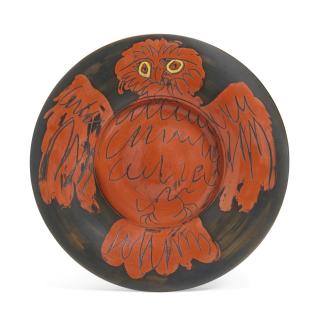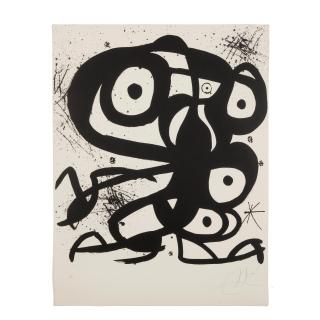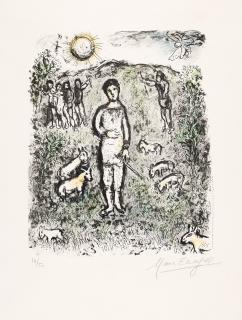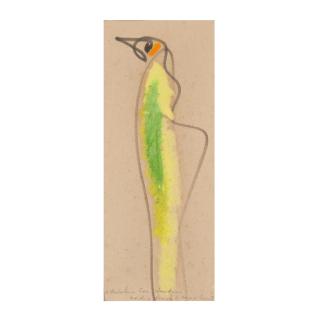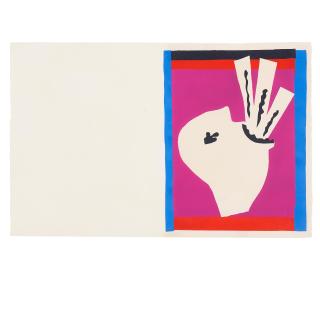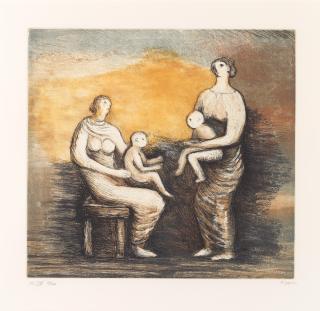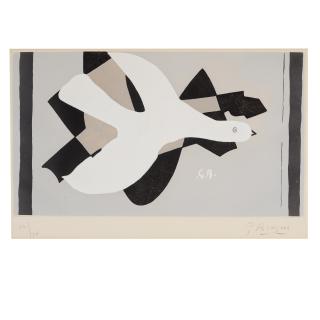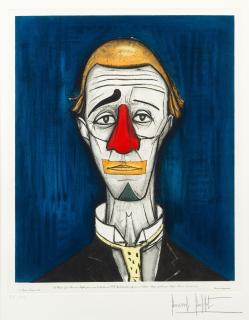Man Ray Philadelphia, Pennsylvania 1890 - 1976 Paris, France
The artist Man Ray
- US photographer, filmmaker, painter and object artist.
- Counts among the most important Dadaists and Surrealists.
- Pioneer of modern photography and experimental film.
Man Ray, born in 1890 in Philadelphia, was headstrong and impatient even as a young man. He began a traditional painter's training, but gave it up again. The studies were too conventional and time-consuming, and he saw too little room for his own freedom. Man Ray, a shortening of his name Emmanuel Rudnitzky, henceforth worked as a map draftsman in Manhattan and attended evening classes at the Modern School of New York, where more unconventional teaching methods suited him. In New York, Ray also met Marcel Duchamp and the Dadaism that would shape Man Ray's early work.
Inspired by Duchamp's readymades, Ray experimented with object art and experimental photography. Around 1919 he developed the Rayographies, technically advanced photograms in which he exposed photographic paper without a camera. Ray temporarily abandoned painting, seeing photographic and object art as the best means for his artistic expression. Ray also created milestones in the history of film when it came to experimental film, such as the pubic hair shave of dada artist Elsa von Freytag-Loringhoven, which is now lost. In later years, however, after the introduction of sound film, Man Ray lost interest in this medium. A desire grew in him to belong to the progressive art world in Europe, so he moved to Paris in the summer of 1921.
Ray quickly learned French and within a short time was accepted in the Dadaist scene. He made commercial portraits and fashion photographs and worked on artistic projects on the side, which soon brought him recognition. The Paris Dadaists fell out and the group split into Dadaists and Surrealists. Ray found the ideal model in Kiki de Montparnasse and his partner from 1922 to 1926, which was also the time he took the surrealist, humor-filled photograph Le Violon d'Ingres, which sold at auction in 2022 for $12.4 million and became the most expensive photograph of all time.
With the onset of World War II, Man Ray returned to the United States. He had to leave most of his works from the last 20 years behind, many were destroyed in the war or have disappeared. Ray arrived in New York together with the famous and celebrated Salvador Dalí, but he himself remained unknown in his homeland. Although he enjoyed commercial success as a photographer in the years that followed, he was denied artistic recognition from Europe. After an unsuccessful phase in Hollywood, Ray lived in Paris again from 1951, where he died in 1976. In 1961, he had still received the gold medal for photography at the Venice Biennale.
Der Künstler Man Ray
- US-amerikanischer Fotograf, Filmemacher, Maler und Objektkünstler.
- Zählt zu den bedeutendsten Dadaisten und Surrealisten.
- Vorreiter der modernen Fotografie und des Experimentalfilms.
Man Ray, 1890 in Philadelphia geboren, war schon als junger Mann eigensinnig und ungeduldig. Eine traditionelle Malerausbildung begann er zwar, gab sie aber wieder auf. Zu konventionell und zeitintensiv war das Studium, er sah zu wenig Raum für eigene Freiheiten. Man Ray, eine Verkürzung seines Namens Emmanuel Rudnitzky, arbeitete fortan als Landkartenzeichner in Manhattan und besuchte Abendkurse in der Modern School of New York, wo ihm unkonventionellere Lehrmethoden entgegenkamen. In New York lernte Ray auch Marcel Duchamp und den Dadaismus kennen, der Man Rays Frühwerk prägen sollte.
Angeregt von Duchamps Readymades experimentierte Ray mit Objektkunst und experimenteller Fotografie. Um 1919 entwickelte er die Rayographien, technisch weiterentwickelte Fotogramme, bei denen er Fotopapier ohne Kamera belichtete. Ray gab die Malerei vorübergehend auf, da er die Foto- und Objektkunst als bestes Mittel für seinen künstlerischen Ausdruck ansah. Auch beim Experimentalfilm schuf Ray Meilensteine der Filmgeschichte wie die Schamhaarrasur der Dadakünstlerin Elsa von Freytag-Loringhoven, die heute verloren ist. In späteren Jahren, nach der Einführung des Tonfilms, verlor Man Ray jedoch das Interesse an diesem Medium. In ihm wuchs der Wunsch, zur progressiven Kunstwelt in Europa zu gehören, weshalb er im Sommer 1921 nach Paris zog.
Ray lernte schnell Französisch und war innerhalb kurzer Zeit in der Dadaistenszene akzeptiert. Er fertigte kommerzielle Porträts und Modefotos an und arbeitete nebenbei an künstlerischen Projekten, die ihm bald Anerkennung verschafften. Die Pariser Dadaisten zerstritten sich und die Gruppe spaltete sich in Dadaisten und Surrealisten. Ray fand in Kiki de Montparnasse das ideale Modell und seine Lebensgefährtin von 1922 bis 1926. Zu dieser Zeit entstand auch das surrealistische, von Humor geprägte Foto Le Violon d’Ingres, das 12,4 Millionen und zur teuersten Fotografie aller Zeiten wurde.
Mit dem Beginn des Zweiten Weltkriegs kehrte Man Ray in die USA zurück. Die meisten seiner Werke aus den letzten 20 Jahren musste er zurücklassen, viele wurden im Krieg zerstört oder sind verschollen. Ray kam gemeinsam mit dem berühmten und gefeierten Salvador Dalí in New York an, er selbst blieb in seiner Heimat dagegen unbekannt. Er konnte zwar in den folgenden Jahren kommerziellen Erfolg als Fotograf verbuchen, doch blieb ihm die künstlerische Anerkennung aus Europa verwehrt. Nach einer erfolglosen Phase in Hollywood wohnte Ray ab 1951 wieder in Paris, wo er 1976 verstarb. 1961 hatte er auf der Biennale von Venedig noch die Goldmedaille für Fotografie erhalten.
Man Ray in a nutshell
Man Ray was a versatile artist who became famous especially with his artist photo portraits and his rayographs. These were advanced photograms, photographs without a camera, so to speak. He is also considered a pioneer of experimental film. Not in New York, but in Paris his Dadaist paintings and collages were equally appreciated.
As a child he lived in New York until he moved to Paris in 1921 in his early 30s. He returned to New York at the beginning of the Second World War. He was not successful there as an artist and followed rumors to Hollywood that one could make it as a film artist. Art in Ray's sense, however, was not wanted in the studio system, which is why he ultimately moved back to Paris in 1951. He lived there until his death in 1976.
Häufige Fragen zu Man Ray
Man Ray war ein vielseitiger Künstler, der besonders mit seinen Künstler-Fotoporträts und seinen Rayographien berühmt wurde. Dies waren weiterentwickelte Fotogramme, sozusagen Fotografien ohne Kamera. Er gilt auch als Vorreiter des Experimentalfilms. Nicht in New York, dafür aber in Paris schätzte man ebenso seine dadaistischen Gemälde und Collagen.
Als Kind lebte er in New York, bis er mit Anfang 30 im Jahr 1921 nach Paris zog. Mit Anfang des Zweiten Weltkriegs kehrte er nach New York zurück. Er war dort als Künstler nicht erfolgreich und folgte Gerüchten nach Hollywood, dass man dort als Filmkünstler durchstarten könne. Kunst in Sinne Rays war jedoch im Studiosystem nicht gewünscht, weshalb er letztlich 1951 wieder nach Paris zog. Dort lebte er bis zu seinem Tod 1976.












![Man Ray - Still Life [Interior] (A. 10)](/images/man-ray_still-life-interior-a-10_AID1228950_320x320.jpg)















